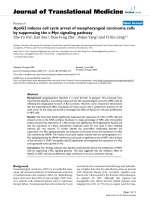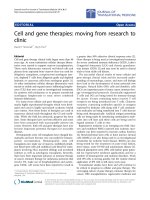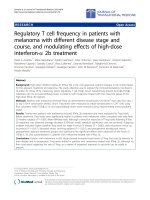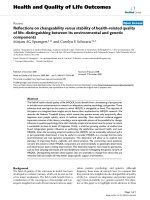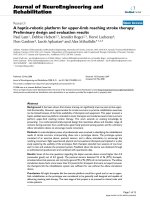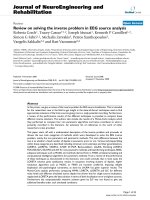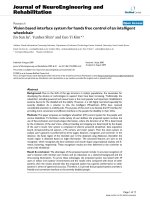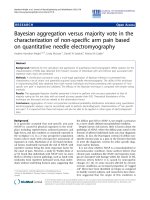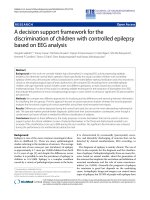o cáo hóa học:" Summit on cell therapy for cancer: The importance of the interaction of multiple disciplines to advance clinical therapy" ppt
Bạn đang xem bản rút gọn của tài liệu. Xem và tải ngay bản đầy đủ của tài liệu tại đây (468.91 KB, 6 trang )
Summit on Cell Therapy for Cancer
November 1-2, 2011 – NIH Campus, Bethesda, MD
Pre-Meeting Report
Interaction • Innovation • Integration • Exchange • Translation • Leadership
Guiding cancer immunotherapy from bench to bedside
www.sitcancer.org
Summit on cell therapy for cancer: The
importance of the interaction of multiple
disciplines to advance clinical therapy
Melief et al.
Melief et al. Journal of Translational Medicine 2011, 9:107
(8 July 2011)
REVIE W Open Access
Summit on cell therapy for cancer: The
importance of the interaction of multiple
disciplines to advance clinical therapy
Cornelis JM Melief
1
, John J O’Shea
2
and David F Stroncek
3*
Abstract
The field of cellular therapy of cancer is moving quickly and the issues involved with its advancement are complex
and wide ranging. The growing clinical applications and success of adoptive cellular therapy of cancer has been
due to the rapid evolution of immunology, cancer biology, gene therapy and stem cell biology and the translation
of advances in these fields from the research laboratory to the clinic. The continued development of this field is
dependent on the exchange of ideas across these diverse disciplines, the testing of new ideas in the research
laboratory and in animal models, the development of new cellular therapies and GMP methods to produce these
therapies, and the testing of new adoptive cell therapies in clinical trials. The Summit on Cell Therapy for Cancer to
held on November 1 and 2, 2011 at the National Institutes of Health (NIH) campus will include a mix of
perspectives, concepts and ideas related to adoptive cellular therapy that are not normally presented together at
any single meeting. This novel assembly will generate new ideas and new collaborations and possibly increase the
rate of advancement of this field.
Review
On November 1 and 2, 2011 at the National Institutes
of Health (NIH) campus in Bethes da, Maryland a multi-
disciplinary summit of laboratory and clinical investig a-
tors and individuals involved in the clinical use,
manufacture, evaluation and regulation of cellular thera-
pies for the treatment of cancer will meet to discuss the
most recent advances and promising cellular therapies
of cancer (cancer .org/meetings/am11/
summit11). The meeting is sponsored by the Society for
Immunotherapy of Cancer (SITC). The purpose of this
Summit is to bring clinical and laboratory investigators
and those involved with producing, assessing and regu-
lating cellular therapies, together to present and discuss
important scientific and technical advances that cur-
rently or will soon impact the field.
The Summit is important because this field is moving
quickly and the issues involved with its advancement are
complex a nd wide ranging. Regular, more focused
immune therapy of cancer meetings remain important
and, in fact, are critical to the advancement of adoptive
cellular therapy of cancer, but this and mo st other areas
of clinical therapy will benefit from the cross-fertili za-
tion that results from the interactions with other related
clinical fields, regulatory agencies and industry.
While immunology, cell biology and cancer biology
have been the corners tones of adoptive cellular therapy,
gene transfer, cell reprogra mming and stem cell biology
are emerging as importan t contributors to this field. All
of these a reas will be discussed at the Summit on Cell
Therapy for Cancer. The meeting will include lectures
on adoptive cellular therapy using tumor infiltrating
lymphocytes (TIL), cytotoxic T cells and natural killer
(NK) cells, reprogramming immune and stem cells, new
methods for cell expansion, regulatory considerations
and bringing new technologies from the research labora-
tory to the clinic.
The clinical promise of cellular therapies is growing
rapidly. The treatment of metastatic melanoma with
TIL, which was pioneered bytheSurgeryBranch,NCI,
NIH, is becoming more effective and its use is becoming
more widespread. Since TIL were first used to success-
fully treat melanoma is 1988 [1], several improvements
have been made. Preconditioning patients with
* Correspondence:
3
Department of Transfusion Medicine Clinical Center, NIH 10 Center Drive-
MSC-1288 Building 10, Room 3C720 Bethesda, Maryland 20892, USA
Full list of author information is available at the end of the article
Melief et al. Journal of Translational Medicine 2011, 9:107
/>© 2011 Melief et al; licensee BioMed Central Ltd. This is an Open Access article distributed u nder the terms of the Creative Commons
Attribution License ( which permits unrestricted use, distribution, and reprod uction in
any medium, provided the original work is properly cited.
lymphocyte depleting chemotherapy increased the pro-
portion of patients with objective clinical responses to
50% [2]. Further intensification of the lymphocyte
depleting preconditioning using cyclophosphamide, flu-
darabine and total body irradiation (TBI) along with
marrow rescue by the administration of autologous
CD34+ isolated from G-CSF mobilized peripheral blood
stem cell products improved objective clinical response
rates to 72% [3,4]. Several institutions are now using
TIL to treat melanoma [4-7]. Other groups have used
expanded antigen specific CD8+ T cells for adoptive cel-
lular therapy of melanoma [8-11]. Some investigators are
using autologous dendritic cells or artificial antigen pre-
senting cells pulsed with tumor antigens to expand cyto-
toxic T cells for melanoma therapy [8,9].
Immune therapy of cancer has spread well beyond the
treatment of melanoma. The field of hematopoietic stem
cell transplantation (HSCT) is moving from a cell repla-
cement therapy to an adoptive cellular therapy. In fact,
in many respects the fields of immune therapy of cancer
and HSCT are merging. The non-myleoablative che-
motherapy and TBI regimen and autologous CD34+ cell
rescue used as part of adoptive cellular therapy proto-
cols used to treat metastatic melanoma are similar to
those used for HSCT. For many years lymphocytes col-
lected from HSCT donors have been infused following
HSCT as an adoptive cellular therapy to treat leukemia
relapse following transplantation; particularly chronic
myelogenous leukemia [12]. Lymphocytes from the
HSCT donor are also being used to treat Epstein-Barr
virus (EBV) associated B cell lymphoproliferative disease
in HSCT recipients. These post-transplant lymphoproli-
ferative diseases (PTLDs) occur most often in recipients
of T cell depleted grafts. PTLD can be treated with the
infusion of unmanipulated donor lymphocytes, but this
is associated with a high risk of graft-versus-host disease
(GVHD). In order to avoid GVHD, PTLDs are being
treated with donor derived EBV-specific T cells [13,14].
These EBV-specific T cells are generated by culturing
donor peripheral blood mononuclear cells (PBMCs)
with EBV-transformed ly mphoblastoid B cell lines (LCL)
which effectively express EBV antigens and function as
antigen presenting cells. Treatment of PTDL with EBV-
specific cytotoxic T lymphocytes (CTLs) is effective in
more than 80% of patients, and when used prophylaxti-
cally in high risk patients is effective at preventing
PTDL [15].
A number of groups are investigating the use of T
cells specific to the leukemia antigens such as Wilms
tumor 1 (WT1) [16,17] and proteinase 3 (PR3) [18] to
prevent or treat leukemia relapse following HSCT. In
addition, recently, vaccination has been able to induc e
robust T cell responses against cancer-associated anti-
gens such as viral oncogenic proteins [19]. This offers
the prospect to combine proper vaccine strategies with
adoptive transfer of specific T cells to achieve optimal T
cell expansion and therapeutic benefit [20].
Adoptive cellular therapy protocols have also begun to
use NK cells. Clinical investigators interes ted in treating
both cancer and hematologic malignancies and leukemia
have been using both allogeneic and autologous nat ural
killer (NK) cells as adoptive cellular therapy. To treat
disease relapse in HSCT recipients with hematologic
malignancies NK cells from the HSCT donors are being
administering post-transplant. Peripheral blood mono-
nuclear cells (PBMCs) collected from the HLA-matched
donors are enriched for NK cells by the depletion of
CD3+ T cells using anti-CD3 immunomagentic beads or
by CD3+ T cell depletion followed by CD56+ cell selec-
tion [21]. T he allogeneic NK cells are administered to
the recipient at the time of disease relapse. The NK cell
recipient is immunosup pressed and treated with IL-2 to
allow for in vivo NK cell expansion. This NK cell ther-
apy has r esulted in complete hematological remission in
5 of 19 patients treated with acute myelogenous leuke-
mia [22]. Similar NK cell preparations and treatment
protocols have been used to treat patients with recur-
rent breast cancer and ovarian cancer [23] and refrac-
tory lymphoma [24]. The patients were given a
lymphodepleting preparative regimen and were then
treated with NK cells from HLA haplotype identical
donors followed by 6 doses of IL-2 therapy. Among the
6 patients with refractory lymphoma, 4 have had objec-
tive clinical responses [24].
Other investigators are using ex vivo expanded auto lo-
gous NK cells as primary therapy for cancer [25]. Auto-
logous NK cells were isolated using a two step process
from PBMC products collected from the patient by
aph eresis. PBMCs in the apheresis product are depleted
of T cell using anti-CD3 immunomagentic bea ds and
then NK cells are sele cted using anti-CD56 immunoma-
gentic beads. The isolated NK cells are then expanded
by incubation with lymphoblastoid cell lines (LCLs) as
feeder cells and IL-2. The autologous expanded NK cells
are being used to treat patients with advanced malignan-
cies [26].
Gene therapy is becoming an important part of cellu-
lar therapy for cancer and hematologic malignancies,
particularly, dendri tic cell (DC) therap y. DCs have been
used in many clinical trials of immunotherapy for can-
cer. For these studies DCs are usually generated by
incubating peripheral blood monocytes with the differ-
entiating agents IL-4 and GM-CSF to produce immature
DCs (iDCs) which are used for some clinical trials, but
for most trials iDCs are incubated with maturation
agents to produce mature DCs (mDCs) [27]. Typically,
DCs are loaded with immune dominant peptides or pro-
teins prior to their administration [8,9], however, many
Melief et al. Journal of Translational Medicine 2011, 9:107
/>Page 2 of 5
clinical trials are now using genetically engineered DCs
to epitope-load HLA antigens [ 17]. For many years
adoptive cellular therapy using genetically engineered
cells has been used to treat Hodgkin’s lymphoma. The
same EBV-specific CTLs that have used to treat PTLD
have also been used to treat EBV-positive Hodgkin’s
Disease (EBV-HD) [14] . While some patients responded
to this thera py, the frequency of T cell clones recogniz-
ing the EBV antigen expressed in Hodgkin’ s disease,
LMP2, is low. As a result LMP2 specific CTLs were gen-
erated by first culturing T cells with DCs transduced
with recombinant adenovirus encoding LMP2A followed
by expansion by culture with LCL transduced with the
same vector [14]. The treatment of 6 patients with high
risk EBV-associated lymphomas in relapse with these
LMP2 specific CTLs resulted in clinical responses in 5
patients [28].
Another very promising use of genetically engineered
cells for the treatment of cancer involves arming autolo-
gous T cells with T cell receptors (TCR) that have a
high affinity to cancer antigens, expanding these geneti-
cally modified T cells in vitro and infusing them into
patients [29]. T cells transduced with a high affinity
TCRs for the melanoma antigens MART-1 and gp100
are being used to treat patients with metastatic mela-
noma [30,31]. Clinical responses were seen in 19% and
30% of patients [30,31]. In addition, high affinity TCRs
specific for NY-ESO-1, a cancer antigen expressed by
approximately 80% of patients with synovial cell sar-
coma and 25% with melanoma, are being transduced
into autologous T cells, the T cells are being expanded
ex vivo and used t o treat patients with metastatic syno-
vial cell sarcoma and metastatic melanoma [32]. This
therapy has resulted in objective clinical responses in 4
of 6 patients with synovial cell sarcoma and five of 11
patients with melanoma [32].
Chimeric antigen T cell receptors (CAR) are also
being use d in adoptive cell therapy of cancer. One CAR
that has been tested clinically is made up of the antigen
recognition portion of CD19, the zeta chain of the T
cell receptor and a portion of the co-stimulatory mole-
cule CD28. Autologous T cells transduced with anti-
CD19 CAR are cytolytic to B cell lymphoma cells that
express CD19 [33]. While clinical trials of these geneti-
cally engineered T cells are just beginning, preliminary
results have been encouraging [34].
In order to improve the effectiveness of adoptive cel-
lular therapies with engineered T cells clinical investiga-
tors have turned to stem cell biology. While any
population of CD8+ T cells can be genetically engi-
neered; naïve, central memory or effector memory cells,
engineered T cells produced from these three different
types of T cells may not be equally effective in treating
cancer. Restifo and colleagues have recently shown that
naïve T cells are more c apable then c entral or effector
memory T cells of expressing TCR transgenes and in
vitro expansion. Furthermore, expanded naïve cells
express lower levels of markers of effector differentiation
which has been associated with greater adoptive cellular
therapy effectiveness and h igher levels of CD27 and
longer telomeres, which suggests that these cells have a
greater in vivo proliferation potential [35]. The number
of naïve T cells in the circulation varies among healthy
subjects [35] and the le vels of circulating native T cells
are likely to be more variable among cancer patients
due to prior cancer chemotherapy or the cancer itself.
Patients who have had extensive chemotherapy may
have very low levels of circulating T cells. As a result,
investigat ors are working on cell reprogramming strate-
gies to produce naïve and stem T cells for adoptive cel-
lular therapy.
Patients are not served until new therapies are
brought to the clinic. Fortunately, the clinical success of
adoptive cellular therapies currently in clinical trials is
driving the development of new cell production technol-
ogies that will make adoptive cellular therapy more fea-
sible. Investigators at Baylor have found that gas-
permeable flasks (e.g., G-Rex flasks, Wilson Wolf Manu-
facturing, New Brighton, MN) can be used to expand
cytotoxic T cells to a much higher concentration than
bags or traditional flasks [36]. Cell culture in G-Rex gas-
permeable flasks requires approximately one-fifth the
quantity of media, AB Serum, IL-2 and anti-CD3, and
less equipment than culturing in bags or flasks. This
reduction in culture volume and media is extremely
important to producing the 10 to 40 × 10
9
cell used for
adoptive cytotoxic T cell and NK cell therapy. Several
groups are currently working to develop and validate
methods to expand, TIL, T cells, engineered T cells and
NK cell in G-Rex gas-permeable flasks. If the promising
preliminary results of T and NK cell growth and expan-
sion in G-Rex flasks continues, these methods will likely
lead to the more widespread use many adoptive cellular
therapies. Cell therapy laboratories are also working
with the manufacturer of the G-Rex flasks, Wilson Wolf
Manufacturing, to produce a larger gas-permeable flasks
specifically designed for g ood manufacturing practice
(GMP) cell growth that will further simply TIL, T cell
and NK cell production.
Adoptive cell therapy requires cell growth and culture
in multiple types of flasks and bags, with a variety of
growth factors, cytokines and antibodies. Cell selection
or depletion using monoclonal antibodies or elutriation
is often used. Cells are sometimes transduced with ret-
roviral or lentiviral vectors. Bringing these complex
therapies to the clinic requires investigators to address a
number of issues related to the safety and effectiveness
of the final product. The United States Food and Drug
Melief et al. Journal of Translational Medicine 2011, 9:107
/>Page 3 of 5
Administration (FDA) is a critical partner in bringing
safe and effective adoptive cellular therapies to the clinic
and addressing the complex regulator issues related to
cellular the rapies. Representatives from the FDA should
be included in forums that address important issues in
the field of adoptive cellular therapy of cancer.
The growing clinical applications and success of adop-
tive cellular therapy of cancer has been due to the rapid
evolution of immunology, gene therapy and stem cell
biology and the translation of advances in these fields
from the research laboratory to the clinic. The contin-
ued development of this field is dependent on the
exchange of ideas across these diverse disciplines, the
testing of new ideas in the research laboratory and in
animal models, the development o f new cellular thera-
pies and GMP methods to produce these therapies, and
the testing of new adoptive cell therapies in clinical
trials. The Summit on Cell Therapy for Cancer will
include a mix of perspectives, concepts and ideas related
to adoptive cell ular therapy that are not normally pre-
sented together at any single meeting. We hope that
this novel assembly will generate new ideas and new
collaborations and possibly increase the rate of advance-
ment of this field.
Acknowledgements
This summit is sponsored by Society for Immunotherapy of Cancer (SITC) in
conjunction with the following participating organizations: AABB (formerly
the American Association of Blood Banks), American Society for Blood and
Marrow Transplantation (ASBMT), American Society of Gene & Cell Therapy
(ASGCT) and Cancer Immunotherapy Trials Network (CITN).
Author details
1
Department of Immunohematology and Blood Transfusion Leiden
University Medical Center 2300 RC Leiden, the Netherlands.
2
Molecular
Immunology and Inflammation Branch National Institute of Arthritis and
Musculoskeletal and Skin Diseases (NIAMS) National Institutes of Health (NIH)
Building 10, Room 6N204 Bethesda, Maryland 20892, USA.
3
Department of
Transfusion Medicine Clinical Center, NIH 10 Center Drive-MSC-1288 Building
10, Room 3C720 Bethesda, Maryland 20892, USA.
Authors’ contributions
CJMM and JJO helped plan and write the manuscript. DFS helped plan the
manuscript and drafted the manuscript. All authors have read and approved
the final manuscript.
Competing interests
The authors declare that they have no competing interests.
Received: 22 June 2011 Accepted: 8 July 2011 Published: 8 July 2011
References
1. Rosenberg SA, Packard BS, Aebersold PM, Solomon D, Topalian SL, Toy ST,
Simon P, Lotze MT, Yang JC, Seipp CA: Use of tumor-infiltrating
lymphocytes and interleukin-2 in the immunotherapy of patients with
metastatic melanoma. A preliminary report. N Engl J Med 1988,
319:1676-1680.
2. Dudley ME, Wunderlich JR, Robbins PF, Yang JC, Hwu P,
Schwartzentruber DJ, Topalian SL, Sherry R, Restifo NP, Hubicki AM,
Robinson MR, Raffeld M, Duray P, Seipp CA, Rogers-Freezer L, Morton KE,
Mavroukakis SA, White DE, Rosenberg SA: Cancer regression and
autoimmunity in patients after clonal repopulation with antitumor
lymphocytes. Science 2002, 298:850-854.
3. Dudley ME, Wunderlich JR, Yang JC, Sherry RM, Topalian SL, Restifo NP,
Royal RE, Kammula U, White DE, Mavroukakis SA, Rogers LJ, Gracia GJ,
Jones SA, Mangiameli DP, Pelletier MM, Gea-Banacloche J, Robinson MR,
Berman DM, Filie AC, Abati A, Rosenberg SA: Adoptive cell transfer
therapy following non-myeloablative but lymphodepleting
chemotherapy for the treatment of patients with refractory metastatic
melanoma. J Clin Oncol 2005, 23:2346-2357.
4. Rosenberg SA, Yang JC, Sherry RM, Kammula US, Hughes MS, Phan GQ,
Citrin DE, Restifo NP, Robbins PF, Wunderlich JR, Morton KE, Laurencot CM,
Steinberg SM, White DE, Dudley ME: Durable Complete Responses in
Heavily Pretreted Patients with Metastatic Melanoma Using T Cell
Transfer Immunotherapy. Clin Cancer Res 2011.
5. Zuliani T, David J, Bercegeay S, Pandolfino MC, Rodde-Astier I, Khammari A,
Coissac C, Delorme B, Saiagh S, Dreno B: Value of large scale expansion of
tumor infiltrating lymphocytes in a compartmentalised gas-permeable
bag: interests for adoptive immunotherapy. J Transl Med 2011, 9:63.
6. Besser MJ, Shapira-Frommer R, Treves AJ, Zippel D, Itzhaki O, Hershkovitz L,
Levy D, Kubi A, Hovav E, Chermoshniuk N, Shalmon B, Hardan I, Catane R,
Markel G, Apter S, Ben-Nun A, Kuchuk I, Shimoni A, Nagler A, Schachter J:
Clinical responses in a phase II study using adoptive transfer of short-
term cultured tumor infiltration lymphocytes in metastatic melanoma
patients. Clin Cancer Res 2010, 16:2646-2655.
7. Labarriere N, Pandolfino MC, Gervois N, Khammari A, Tessier MH, Dreno B,
Jotereau F: Therapeutic efficacy of melanoma-reactive TIL injected in
stage III melanoma patients. Cancer Immunol Immunother 2002,
51:532-538.
8. Mackensen A, Meidenbauer N, Vogl S, Laumer M, Berger J, Andreesen R:
Phase I study of adoptive T-cell therapy using antigen-specific CD8+ T
cells for the treatment of patients with metastatic melanoma. J Clin
Oncol 2006, 24:5060-5069.
9. Mitchell MS, Darrah D, Yeung D, Halpern S, Wallace A, Voland J, Jones V,
Kan-Mitchell J: Phase I trial of adoptive immunotherapy with cytolytic T
lymphocytes immunized against a tyrosinase epitope. J Clin Oncol 2002,
20:1075-1086.
10. Yee C, Thompson JA, Byrd D, Riddell SR, Roche P, Celis E, Greenberg PD:
Adoptive T cell therapy using antigen-specific CD8+ T cell clones for the
treatment of patients with metastatic melanoma: in vivo persistence,
migration, and antitumor effect of transferred T cells. Proc Natl Acad Sci
USA 2002, 99:16168-16173.
11. Khammari A, Labarriere N, Vignard V, Nguyen JM, Pandolfino MC, Knol AC,
Quereux G, Saiagh S, Brocard A, Jotereau F, Dreno B: Treatment of
metastatic melanoma with autologous Melan-A/MART-1-specific
cytotoxic T lymphocyte clones. J Invest Dermatol 2009, 129:2835-2842.
12. Kolb HJ, Schattenberg A, Goldman JM, Hertenstein B, Jacobsen N,
Arcese W, Ljungman P, Ferrant A, Verdonck L, Niederwieser D, van RF,
Mittermueller J, de WT, Holler E, Ansari H: Graft-versus-leukemia effect of
donor lymphocyte transfusions in marrow grafted patients. Blood 1995,
86:2041-2050.
13. Heslop HE: How I treat EBV lymphoproliferation.
Blood 2009,
114:4002-4008.
14.
Bollard CM, Cooper LJ, Heslop HE: Immunotherapy targeting EBV-
expressing lymphoproliferative diseases. Best Pract Res Clin Haematol
2008, 21:405-420.
15. Gottschalk S, Rooney CM, Heslop HE: Post-transplant lymphoproliferative
disorders. Annu Rev Med 2005, 56:29-44.
16. Maslak PG, Dao T, Krug LM, Chanel S, Korontsvit T, Zakhaleva V, Zhang R,
Wolchok JD, Yuan J, Pinilla-Ibarz J, Berman E, Weiss M, Jurcic J, Frattini MG,
Scheinberg DA: Vaccination with synthetic analog peptides derived from
WT1 oncoprotein induces T-cell responses in patients with complete
remission from acute myeloid leukemia. Blood 2010, 116:171-179.
17. Van T V, Van d V, Van D A, Cools N, Anguille S, Ladell K, Gostick E,
Vermeulen K, Pieters K, Nijs G, Stein B, Smits EL, Schroyens WA,
Gadisseur AP, Vrelust I, Jorens PG, Goossens H, de V I, Price DA, Oji Y, Oka Y,
Sugiyama H, Berneman ZN: Induction of complete and molecular
remissions in acute myeloid leukemia by Wilms’ tumor 1 antigen-
targeted dendritic cell vaccination. Proc Natl Acad Sci USA 2010,
107:13824-13829.
18. Molldrem JJ, Clave E, Jiang YZ, Mavroudis D, Raptis A, Hensel N, Agarwala V,
Barrett AJ: Cytotoxic T lymphocytes specific for a nonpolymorphic
Melief et al. Journal of Translational Medicine 2011, 9:107
/>Page 4 of 5
proteinase 3 peptide preferentially inhibit chronic myeloid leukemia
colony-forming units. Blood 1997, 90:2529-2534.
19. Kenter GG, Welters MJ, Valentijn AR, Lowik MJ, Berends-van der Meer DM,
Vloon AP, Essahsah F, Fathers LM, Offringa R, Drijfhout JW, Wafelman AR,
Oostendorp J, Fleuren GJ, van der Burg SH, Melief CJ: Vaccination against
HPV-16 oncoproteins for vulvar intraepithelial neoplasia. N Engl J Med
2009, 361:1838-1847.
20. Ly LV, Sluijter M, Versluis M, Luyten GP, van der Burg SH, Melief CJ,
Jager MJ, van HT: Peptide vaccination after T-cell transfer causes massive
clonal expansion, tumor eradication, and manageable cytokine storm.
Cancer Res 2010, 70:8339-8346.
21. McKenna DH Jr, Sumstad D, Bostrom N, Kadidlo DM, Fautsch S,
McNearney S, Dewaard R, McGlave PB, Weisdorf DJ, Wagner JE,
McCullough J, Miller JS: Good manufacturing practices production of
natural killer cells for immunotherapy: a six-year single-institution
experience. Transfusion 2007, 47:520-528.
22. Miller JS, Soignier Y, Panoskaltsis-Mortari A, McNearney SA, Yun GH,
Fautsch SK, McKenna D, Le C, DeFor TE, Burns LJ, Orchard PJ, Blazar BR,
Wagner JE, Slungaard A, Weisdorf DJ, Okazaki IJ, McGlave PB: Successful
adoptive transfer and in vivo expansion of human haploidentical NK
cells in patients with cancer. Blood 2005, 105:3051-3057.
23. Geller MA, Cooley S, Judson PL, Ghebre R, Carson LF, Argenta PA,
Jonson AL, Panoskaltsis-Mortari A, Curtsinger J, McKenna D, Dusenbery K,
Bliss R, Downs LS, Miller JS: A phase II study of allogeneic natural killer
cell therapy to treat patients with recurrent ovarian and breast cancer.
Cytotherapy 2011, 13:98-107.
24. Bachanova V, Burns LJ, McKenna DH, Curtsinger J, Panoskaltsis-Mortari A,
Lindgren BR, Cooley S, Weisdorf D, Miller JS: Allogeneic natural killer cells
for refractory lymphoma. Cancer Immunol Immunother 2010, 59:1739-1744.
25. Berg M, Lundqvist A, McCoy P Jr, Samsel L, Fan Y, Tawab A, Childs R:
Clinical-grade ex vivo-expanded human natural killer cells up-regulate
activating receptors and death receptor ligands and have enhanced
cytolytic activity against tumor cells. Cytotherapy 2009, 11:341-355.
26. Berg M, Childs R: Ex-vivo expansion of NK cells: what is the priority–high
yield or high purity? Cytotherapy 2010, 12:969-970.
27. Castiello L, Sabatino M, Jin P, Clayberger C, Marincola FM, Krensky AM,
Stroncek DF: DC maturation strategies and related pathways: a
transcriptional veiw. Curr Opin Immunol 2010.
28. Bollard CM, Gottschalk S, Leen AM, Weiss H, Straathof KC, Carrum G,
Khalil M, Wu MF, Huls MH, Chang CC, Gresik MV, Gee AP, Brenner MK,
Rooney CM, Heslop HE: Complete responses of relapsed lymphoma
following genetic modification of tumor-antigen presenting cells and T-
lymphocyte transfer. Blood 2007, 110:2838-2845.
29. Morgan RA, Dudley ME, Rosenberg SA: Adoptive cell therapy: genetic
modification to redirect effector cell specificity. Cancer J 2010, 16:336-341.
30. Johnson LA, Morgan RA, Dudley ME, Cassard L, Yang JC, Hughes MS,
Kammula US, Royal RE, Sherry RM, Wunderlich JR, Lee CC, Restifo NP,
Schwarz SL, Cogdill AP, Bishop RJ, Kim H, Brewer CC, Rudy SF, VanWaes C,
Davis JL, Mathur A, Ripley RT, Nathan DA, Laurencot CM, Rosenberg SA:
Gene therapy with human and mouse T-cell receptors mediates cancer
regression and targets normal tissues expressing cognate antigen. Blood
2009, 114:535-546.
31. Morgan RA, Dudley ME, Wunderlich JR, Hughes MS, Yang JC, Sherry RM,
Royal RE, Topalian SL, Kammula US, Restifo NP, Zheng Z, Nahvi A, de
Vries CR, Rogers-Freezer LJ, Mavroukakis SA, Rosenberg SA: Cancer
regression in patients after transfer of genetically engineered
lymphocytes. Science 2006, 314:126-129.
32. Robbins PF, Morgan RA, Feldman SA, Yang JC, Sherry RM, Dudley ME,
Wunderlich JR, Nahvi AV, Helman LJ, Mackall CL, Kammula US, Hughes MS,
Restifo NP, Raffeld M, Lee CC, Levy CL, Li YF, El-Gamil M, Schwarz SL,
Laurencot C, Rosenberg SA: Tumor regression in patients with metastatic
synovial cell sarcoma and melanoma using genetically engineered
lymphocytes reactive with NY-ESO-1. J Clin Oncol 2011, 29:917-924.
33. Kochenderfer JN, Yu Z, Frasheri D, Restifo NP, Rosenberg SA: Adoptive
transfer of syngeneic T cells transduced with a chimeric antigen
receptor that recognizes murine CD19 can eradicate lymphoma and
normal B cells. Blood 2010, 116:3875-3886.
34. Kochenderfer JN, Wilson WH, Janik JE, Dudley ME, Stetler-Stevenson M,
Feldman SA, Maric I, Raffeld M, Nathan DA, Lanier BJ, Morgan RA,
Rosenberg SA: Eradication of B-lineage cells and regression of lymphoma
in a patient treated with autologous T cells genetically engineered to
recognize CD19. Blood 2010, 116:4099-4102.
35. Hinrichs CS, Borman ZA, Gattinoni L, Yu Z, Burns WR, Huang J,
Klebanoff CA, Johnson LA, Kerkar SP, Yang S, Muranski P, Palmer DC,
Scott CD, Morgan RA, Robbins PF, Rosenberg SA, Restifo NP: Human
effector CD8+ T cells derived from naive rather than memory subsets
possess superior traits for adoptive immunotherapy. Blood 2011,
117:808-814.
36. Vera JF, Brenner LJ, Gerdemann U, Ngo MC, Sili U, Liu H, Wilson J, Dotti G,
Heslop HE, Leen AM, Rooney CM: Accelerated production of antigen-
specific T cells for preclinical and clinical applications using gas-
permeable rapid expansion cultureware (G-Rex). J Immunother 2010,
33:305-315.
doi:10.1186/1479-5876-9-107
Cite this article as: Melief et al.: Summit on cell therapy for cancer: The
importance of the interaction of multiple disciplines to advance clinical
therapy. Journal of Translational Medicine 2011 9:107.
Submit your next manuscript to BioMed Central
and take full advantage of:
• Convenient online submission
• Thorough peer review
• No space constraints or color figure charges
• Immediate publication on acceptance
• Inclusion in PubMed, CAS, Scopus and Google Scholar
• Research which is freely available for redistribution
Submit your manuscript at
www.biomedcentral.com/submit
Melief et al. Journal of Translational Medicine 2011, 9:107
/>Page 5 of 5
